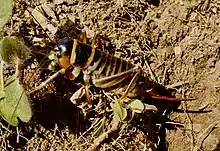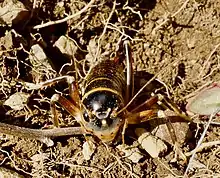Hemiandrus focalis
Hemiandrus focalis is a species of ground wētā endemic to New Zealand. This flightless Orthoptera lives in the mountains of the South Island, New Zealand.[2] This species can be distinguished from other ground wētā by their three superior retrolateral spines on their mid tibia and females have relatively long ovipositors.[3] This omnivorous ground wētā species is listed as "not threatened" by the New Zealand Department of Conservation.[4]
| Hemiandrus focalis | |
|---|---|
 | |
| Adult female near Bannockburn, South Island, New Zealand | |
| Scientific classification | |
| Domain: | Eukaryota |
| Kingdom: | Animalia |
| Phylum: | Arthropoda |
| Class: | Insecta |
| Order: | Orthoptera |
| Suborder: | Ensifera |
| Family: | Anostostomatidae |
| Genus: | Hemiandrus |
| Species: | H. focalis |
| Binomial name | |
| Hemiandrus focalis (Hutton, 1896) | |
| Synonyms | |
| |
.jpg.webp)
Taxonomy
Hemiandrus focalis was formally placed in the genus Zealandosandrus by Salmon in 1950.[5] The genus Zealandosandrus was formed to separate species with the distinct traits of long ovipositors and the absence of a modified 6th abdominal sternite in female wētā.[6] However, this genus is now regarded as synonymous with Hemiandrus[2], as some ground wētā species have intermediate length ovipositers[2][7] and Hemiandrus focalis has weakly developed paramedian lobes on the female 6th sternite.[8]
Morphology
This species can be distinguished from other ground wētā by their three superior retrolateral spines on their mid tibia and females have relatively long ovipositors.[3] Ovipositor length vary in different ground wētā species. Hemiandrus focalis is one of about ten Hemiandrus species with females possessing long ovipositors.[2][9][10] The tarsus of H. focalis is also described as bare with only a few erect setae.
Habitat and distribution
All species within the genus Hemiandrus are nocturnal.[2] Individuals of H. focalis are found during the day in soil burrows in native forest or in burrows of stony silts in open habitat.[2] The habitat of Hemiandrus focalis extends into high elevation in the alpine zone above the tree line.[9] This species are distributed across the mountains of New Zealand's South Island and also found present on Codfish Island.[2]
Diet
Hemiandrus focalis is one of the Hemiandrus species that has an omnivorous diet.[2] Omnivorous ground wētā such as H. maia are found to consume fruits, seeds and other invertebrates.[9]
Mating and Breeding
Hemiandrus focalis lay their eggs in the ground similar to the suborder Ensifera.[6] The long ovipositors in the females suggest that they do not have maternal care.[6] This species may take three years to reach maturity.[8]
Nuptial gifting occurs in Hemiandrus species where the male attaches a spermatophylax with the sperm ampulla onto the female when mating.[6] Although the mating process of the H. focalis has not be recorded specifically, Hemiandrus species with long ovipositors have been recorded to have a spermatophylax attached to the sperm ampulla.[11]

Conservation
This species is classified as "not threatened" by the New Zealand Department of Conservation in 2014. Ground wētā are important as they are part of the diet of native kiwi[12] They are also eaten by introduced mammals in New Zealand such as hedgehogs[13] and stoats.[14]
References
- Johns, Peter (2001). "Distribution and conservation status of ground weta, Hemiandrus species (Orthoptera: Anostostomatidae)". Science for Conservation, New Zealand Department of Conservation. 180: 1–24.
- Johns, P. M. (1997). "The Gondwanaland Weta: Family Anostostomatidae (Formerly in Stenopelmatidae, Henicidae or Mimnermidae): Nomenclatural Problems, World Checklist, New Genera and Species". Journal of Orthoptera Research (6): 125–138. doi:10.2307/3503546. ISSN 1082-6467. JSTOR 3503546.
- Smith, BL Taylor; Morgan-Richards, M.; Trewick, S. A. (2013). "New Zealand ground wētā (Anostostomatidae: Hemiandrus): descriptions of two species with notes on their biology". New Zealand Journal of Zoology. 40 (4): 314–329. doi:10.1080/03014223.2013.804422. ISSN 0301-4223.
- Trewick, S. A.; Morris, S. J.; Johns, P. M.; Hitchmough, R. A.; Stringer, I. A.N. (2012-06-21). "The conservation status of New Zealand Orthoptera". New Zealand Entomologist. 35 (2): 131–136. doi:10.1080/00779962.2012.686318. ISSN 0077-9962. S2CID 219564547.
- Salmon, J. T. (1950). "Revision of the New Zealand Wetas Anostostominae (Orthoptera: Stenopelmatidae)". Dominion Museum Records in Entomology. 1 (8): 121–177.
- Gwynne, Darryl T. (2004). "Reproductive Behavior of Ground Weta (Orthoptera: Anostostomatidae): Drumming Behavior, Nuptial Feeding, Post-copulatory Guarding and Maternal Care". Journal of the Kansas Entomological Society. 77 (4): 414–428. doi:10.2317/e-34.1. ISSN 0022-8567. S2CID 86709108.
- Smith, BL Taylor; Morgan-Richards, M.; Trewick, S. A. (2013). "New Zealand ground wētā (Anostostomatidae: Hemiandrus): descriptions of two species with notes on their biology". New Zealand Journal of Zoology. 40 (4): 314–329. doi:10.1080/03014223.2013.804422. ISSN 0301-4223.
- Johns, P. M. (2001). Distribution and conservation status of ground weta, Hemiandrus species (Orthoptera: Anostostomatidae). New Zealand. Department of Conservation. Wellington, N.Z.: Dept. of Conservation. ISBN 0-478-22134-7. OCLC 50737260.
- Derraik, José G. B.; Barratt, Barbara I. P.; Sirvid, Phil; Macfarlane, Roderick P.; Patrick, Brian H.; Early, John; Eyles, Alan C.; Johns, Peter M.; Fraser, Patricia M.; Barker, Gary M.; Henderson, Rosa (2001). "Invertebrate survey of a modified native shrubland, Brookdale Covenant, Rock and Pillar Range, Otago, New Zealand". New Zealand Journal of Zoology. 28 (3): 273–290. doi:10.1080/03014223.2001.9518270. ISSN 0301-4223.
- Trewick, Steven A. (2021). "A new species of large Hemiandrus ground wētā (Orthoptera: Anostostomatidae) from North Island, New Zealand". Zootaxa. 4942 (2): 207–218. doi:10.11646/zootaxa.4942.2.4. ISSN 1175-5334. PMID 33757066. S2CID 232337351.
- Brown, W. D.; Gwynne, D. T. (1997). "Evolution of mating in crickets, katydids and wetas (Ensifera)". Bionomics of Grasshoppers, Katydids, and Their Kin: 281–314 – via AGRIS.
- Colbourne, Rogan; Baird, Karen; Jolly, Jim (October 1990). "Relationship between invertebrates eaten by little spotted kiwi, Apteryx owenii , and their availability on Kapiti Island, New Zealand". New Zealand Journal of Zoology. 17 (4): 533–542. doi:10.1080/03014223.1990.10422951. ISSN 0301-4223.
- Jones, Chris; Moss, Kirsten; Sanders, Mark (2005). "Diet of hedgehogs (Erinaceus europaeus) in the upper Waitaki Basin, New Zealand: Implications for conservation". New Zealand Journal of Ecology. 29 (1): 29–35. ISSN 0110-6465. JSTOR 24056190.
- Smith, D.H.V; Jamieson, I.G.; Peach, R.M.E. (2005). "Importance of ground weta (Hemiandrus spp.) in stoat (Mustela erminea) diet in small montane valleys and alpine grasslands". New Zealand Journal of Ecology. 29 (2): 207–214. ISSN 0110-6465. JSTOR 24058176.